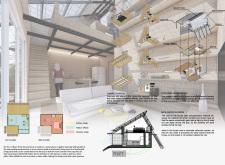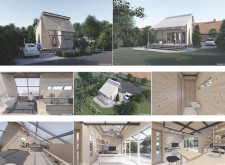5 key facts about this project
Efficient spatial arrangement characterizes the Gubug Banar, with a layout that optimizes the available footprint. The first floor serves as the social area, encouraging community and interaction, while the second floor is dedicated to private living zones. This two-story model allows for diverse experiences within a compact structure, emphasizing both shared and personal spaces.
Innovative Design Strategies
A key distinguishing feature of the Gubug Banar is its emphasis on sustainable building practices. Natural lighting is prioritized through strategically placed windows and a transparent polycarbonate roof. This design choice not only enhances the aesthetic appeal of the interior but also reduces reliance on artificial lighting. Additionally, a rainwater harvesting system is implemented to efficiently manage water resources, aligning with sustainable living practices.
The project also incorporates a sloped roof design, which aids in climate responsiveness, capturing rainwater effectively and promoting ventilation. The choice of materials further identifies the Gubug Banar, utilizing recycled timber and hollow-core panels to minimize environmental impact and ensure cost-effectiveness. The use of local materials reflects a commitment to cultural authenticity and enhances the building’s integration into its surroundings.
Functional Aspects of the Design
The functional zoning within the Gubug Banar optimizes daily living experiences. The open-plan layout encourages interaction among occupants, with spaces designed for versatile use. The living area, suitable for gatherings, smoothly transitions into outdoor spaces, seamlessly blending interior and exterior living environments. The thoughtful arrangement ensures privacy is maintained in sleeping areas while still allowing for communal engagement.
Furthermore, the design is tailored to adapt over time. Modular elements, such as removable partitions and flexible furniture arrangements, grant inhabitants the ability to modify their space according to evolving needs. This adaptability is a critical aspect of modern living in urban areas, effectively addressing the dynamic lifestyles of young professionals.
Overall, Gubug Banar serves as a notable example of how contemporary architecture can rethink traditional ideas of housing. The project emphasizes sustainability, community engagement, and flexibility within its compact design. For more in-depth information about the architectural plans, sections, and ideas that underpin this project, readers are encouraged to explore the project presentation further.

























